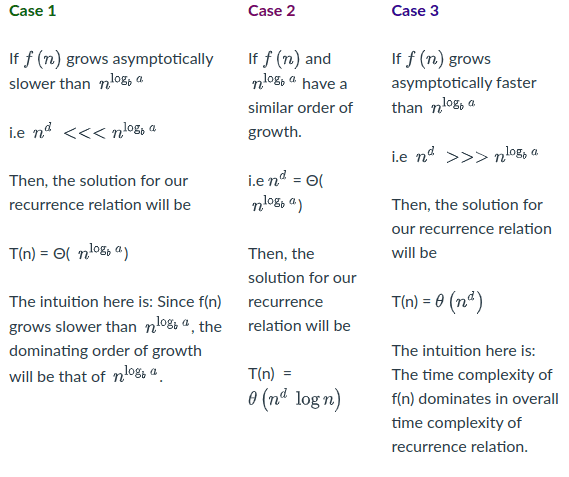recursion in algorithms
If you have a problem that can be solved by breaking the problem into smaller problems then you can use recursion to solve it.
Example:
Factorial of n = n*(n-1) * (n-2) ... 3 * 2 * 1
1 Factorial(n):
2 if n = 0:
3 return 1
4 else:
5 return n * Factorial(n-1)
Expressing the Factorial function F in terms of itself can be done:
F(n) = n* F(n-1)
The expression of a function in terms of itself is a recurrence relation. * Requires a base case * Requires smaller sub-problems that solve instances of the big problem
Recurrence relations
To analyze a recursive algorithm, similar to iterative, we need to express it as an equation to determine the order of growth.
Terms
c- constant timeT(n)- recursive function execution, subsequent call onT(n-1)
Example
The Factorial recurrence relation can be written as:
T(n) = c1 or Θ(1) when n=0 (this represents base case, and c1 is some constant)
T(n) = T(n-1) + c when n>0 (this represents recursive case)
T(n) = T(n-1) + Θ(1) when n>0 since Θ(1) represents constant time
Recursion-tree method
When a recursive algorithm makes more than a single call to itself, analysis can be done by constructing a tree of the recursive calls. It is a visual representation of recursionw here each node of the tree represents the cost of a recursive sub-problem. This tree is a recursion tree. Summing the nodes gives the cost of the engire algorithm.
Example
This is sometimes unreliable, but accurate time complexity can be found by using the substitution method.
c1 for n=1 (when start = end)
T(n)
2T(n/2) + cn for n>1
Level 0
Making 2 recursive calls in the same execution.
Level 0 T(n) cn
/ \
Level 1 T(n/2) T(n/2)
Level 1
We can find the expansion of T(n/2) it can be writtn as 2T(n/4) + c(n/2)
Level 1 T(n/2) cn/2
/ \
Level 2 T(n/4) T(n/4)
Level 2
We can find the expansion of T(n/4) it can be writtn as:
Level 2 T(n/2) cn/4
/ \
Level 3 T(n/8) T(n/8)
The master method
Master metod enables solving for recurrence relation of the form T(n) = aT(n/b) + f(n).
Where a >= 1, b > 1, and f(n) > 0.
Example
T(n) = T(n/2) + c; here a = 1, b =2 and f(n) = c
T(n) = 3T(n/2)+ cn; here a = 3, b = 2 and f(n) = cn
In this method, n^logb a and f(n) values are compared. When comparing two
functions there are three cases n^logb a grows asymptotically at a faster rate
than f(n), or n^logb a grows at a slower rate than f(n), or both have same order
of growth.
For simplicity consider f(n)∈ Θ(n^d) so that we can easily compare n^d and n^logb a.
This screenshot showcases the different growth type comparisons:
Looking at the cases we can make examples:
Limitations of master method
Recurrence relation satisfies a few conditions before applying the master method. This brings these limitations:
- Recurrence must satisfy
a >= 1, b > 1, f(n)is a positive function - Master method cannot be applied if
f(n)is not a polynomial function - Master method cannot be applied if
aorbcannot be expressed as a constant
Special case
f(n) ∈ Θ(n^(logb a) * log^k(n)) for some k >= 0 then T(n) = Θ(n^(logb a) * log^(k+1)(n))

